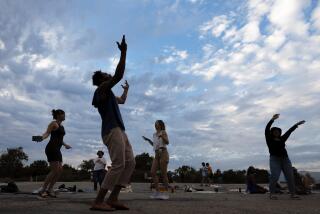A little toast to the end of a dry era
- Share via
MOST historical holidays commemorate auspicious beginnings -- the ratification of the Declaration of Independence, the pilgrims’ earliest Thanksgiving, our first president’s birthday -- but sometimes it’s the endings we celebrate. After 13 long, dry years, including the early part of the Great Depression, the repeal of Prohibition must have felt like the end of a war.
“We tend to look at Prohibition as a glamorous [era] of speak-easies filled with beautiful people clinking glasses and dancing. But all the things that make that time seem like so much fun took place against a very ugly backdrop of labor disputes, economic disaster, crime and violence,” says Mitzi Mogul, vice president of the board of the Heritage Square Museum and a former president of the Art Deco Society of Los Angeles.
Seventy-five years removed from the trauma of banned booze, it’s the “Bonnie and Clyde” mystique of the Roaring ‘20s that dominates our collective cultural memory. And that’s the spirit that infuses the two historical organizations’ End of Prohibition Era Picnic. Featuring vintage cars, an outdoor dance floor, live band the Bilgewater Rats strumming swing tunes from the era and Prohibition-inspired cocktails served out of a bathtub, would-be flappers, gangsters and molls are encouraged to dress in period clothes and bring their own picnic lunches for an afternoon of “deco”-dence. You won’t even have to hide your flask in your garter.
Hailed by Herbert Hoover (then the Secretary of Commerce) as “a great social and economic experiment, noble in motive,” the 18th Amendment that ushered in Prohibition was signed into law in January 1920. But human desire, unlike the laws that attempted to corral it, remained unchanged. “These were the people who cheered the death of the saloon only to see it replaced by the speak-easy,” Mogul says. “People want what they want, and they will find a way to acquire it. It became a big game for gangsters and bootleggers, and the public more than cooperated in these creative schemes to purchase and consume alcohol.”
In Los Angeles, the coastline was dotted with gambling ships moored just outside the one-mile limit. And the Georgian Hotel, which stills sits on Ocean Avenue in Santa Monica, had a downstairs speak-easy complete with a revolving wall. Other solutions required more inventiveness. Vine Glow, a freeze-dried brick that could be reconstituted as grape juice when combined with water, came with conveniently detailed instructions on how not to add yeast or some other type of malt tonic to create alcohol. Because that would be illegal.
Thirteen years later, President Hoover, like many Americans, considered Prohibition a failure. And in 1933, this experiment in forced temperance was repealed by the 21st Amendment. As Mogul says, “I imagine more than a few people needed a good stiff drink.”
--
-- Elina.Shatkin@latimes.com
--
END OF PROHIBITION ERA PICNIC
WHERE: Heritage Square Museum, 3800 Homer St., L.A.
WHEN: 1-5 p.m. Saturday
PRICE: $62 (includes one-year admission to Heritage Square Museum and ADSLA)
INFO: (323) 225-2700, Ext. 223; www.heritagesquare .org
More to Read
Sign up for The Wild
We’ll help you find the best places to hike, bike and run, as well as the perfect silent spots for meditation and yoga.
You may occasionally receive promotional content from the Los Angeles Times.






